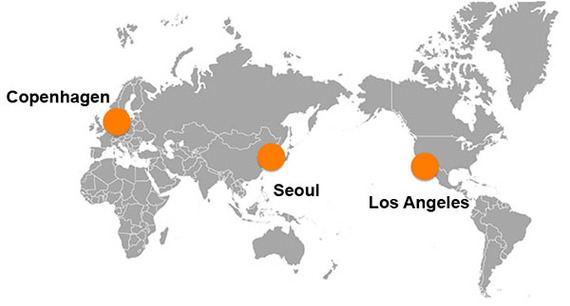Co-written by Johan Vardrup
Startup hubs are popping up like mushrooms across the world, each with its own culture, competitive advantages and opportunities for creating unique businesses. What might these hubs learn from each other to dial up their performance?
To answer this question we spoke with professionals in Copenhagen, Seoul and Los Angeles, analyzing their work and home cultures, risk-attitudes and other cultural characteristics.
Copenhagen
With the urban area of Copenhagen housing 2.8 million of the country's 5.8 million homogeneous population (89.6% are of Danish descent), Denmark is far too small a market for a viable startup. The current generation merely thinks about their country as a point of departure for expansion. Excellent English skills and good European contact (market of 500 million people) helps make this possible.
In Denmark there is limited risk willing capital available for startups and therefore the government gets involved. A new effort, propelled by Rainmaking Loft and the state-run Business Authority, addresses this by promoting the best homegrown startups for international venture funds.
The Danish Startup Council assembles the various communities and among the members are national universities, because they increasingly fuel startup successes. Since Danish higher education is free for all, the academic scene has the potential to become an accessible and fertile startup motor.
Danes handle ambiguity well and have a relatively high tolerance for risk so this is a big upside for starting out on one's own there. They also place a premium on enjoying life, (average work year is 1600 hours), which may naturally not attract one to an entrepreneurial career or slow down the growth of a business.
Seoul
With half of South Korea's homogenous population of fifty million now living in Seoul (96.5% are South Koreans), Korea's domestic market is big enough to found a startup, however too small to sustain unicorn growth. To accomplish this, startups need to engage with the international market, which is a challenge due to inadequate networks outside of South Korea and limited English speaking skills.
Fiercely competitive and with no tolerance for failure, South Koreans are accustomed to working long hours (average work year is 2200 hours). South Koreans are, however, uncomfortable with ambiguity and risk and have a culture of seeking employment in the country's large international manufacturing organizations. Venture financing is thus hard to come by, as well as, qualified professionals that are willing to work for a high-risk startup.
In their collectivist culture, standing out can also be uncomfortable for Koreans. With one chance to succeed, there is a tremendous pressure to perform and succeed in the first startup endeavor, since one is unlikely to get a second chance.
Los Angeles
The Greater Los Angeles area is a melting pot of twelve million people (30% white, 50% Hispanic, 10% black and 10% Asian) with the largest and most diverse economy in the United States. Startups blossom here, particularly in Santa Monica and the San Gabriel Valley.
With three hundred and ten million English-speaking Americans, a sufficiently large home market of early innovators and early adopters are more likely to be found. Subsequent scaling to early majority users is also easier though online and traditional advertising. Risk willing capital is more readily available than in Copenhagen and Seoul, however, still lags behind Silicon Valley.
Los Angelinos are comfortable with standing out, taking risks and working hard (average work year is 2000 hours). Entrepreneurs in Santa Monica tend to be younger and establish consumer oriented web based enterprises while entrepreneurs In Pasadena and the San Gabriel Valley, tend to be experienced midcareer professionals with families to support.
Research and engineering plays a larger role in Pasadena due to the presence of Caltech, JPL, Harvey Mudd and lots of aerospace know-how. The focus here is more on business-to-business solutions, requiring entrepreneurs to understand industry problems and behaviors before coming up with solutions.
It is clear that entrepreneurs in Copenhagen, Seoul and Los Angeles face very different challenges, from risk willingness, types of available qualified professionals, market access and language barriers. Fundraising is also either publicly supported, or funded by private institutions or mainly by one's family friends and fools. By learning from cultures thousands of miles apart and building international networks, entrepreneurs can more easily gain the tacit knowledge for finding novel opportunities and solutions that speak to their unique environment.
Special thanks to Johan Vardrup, Kristian Justesen, Andy Wilson and Jaewoo Joo for researching this article
